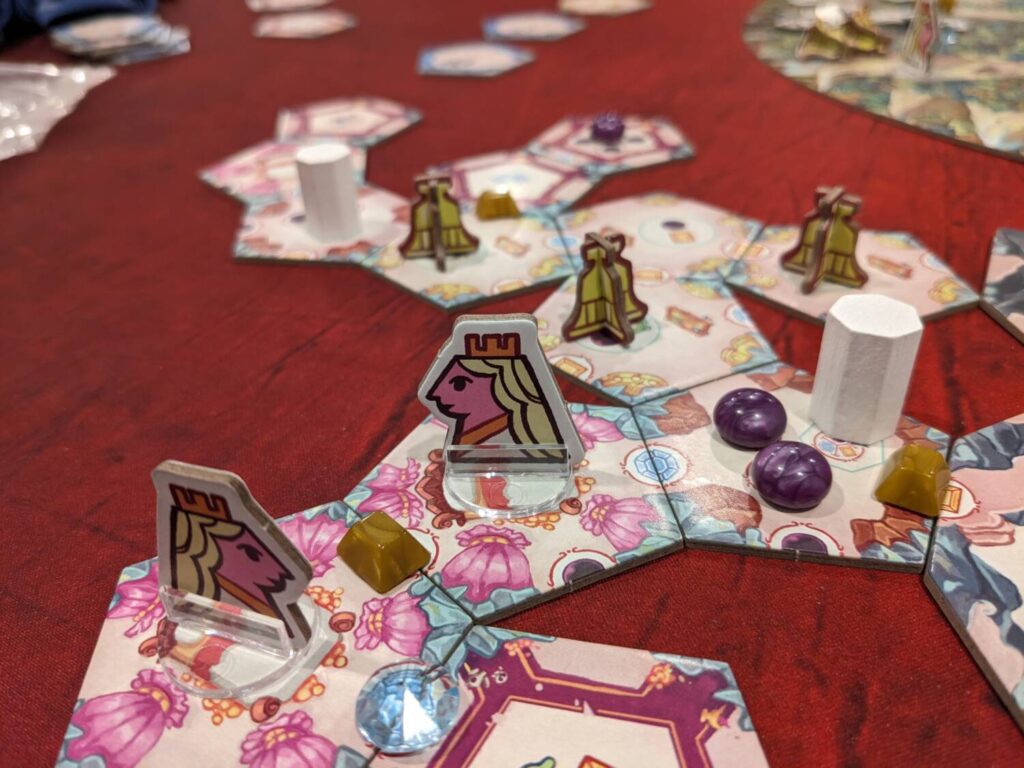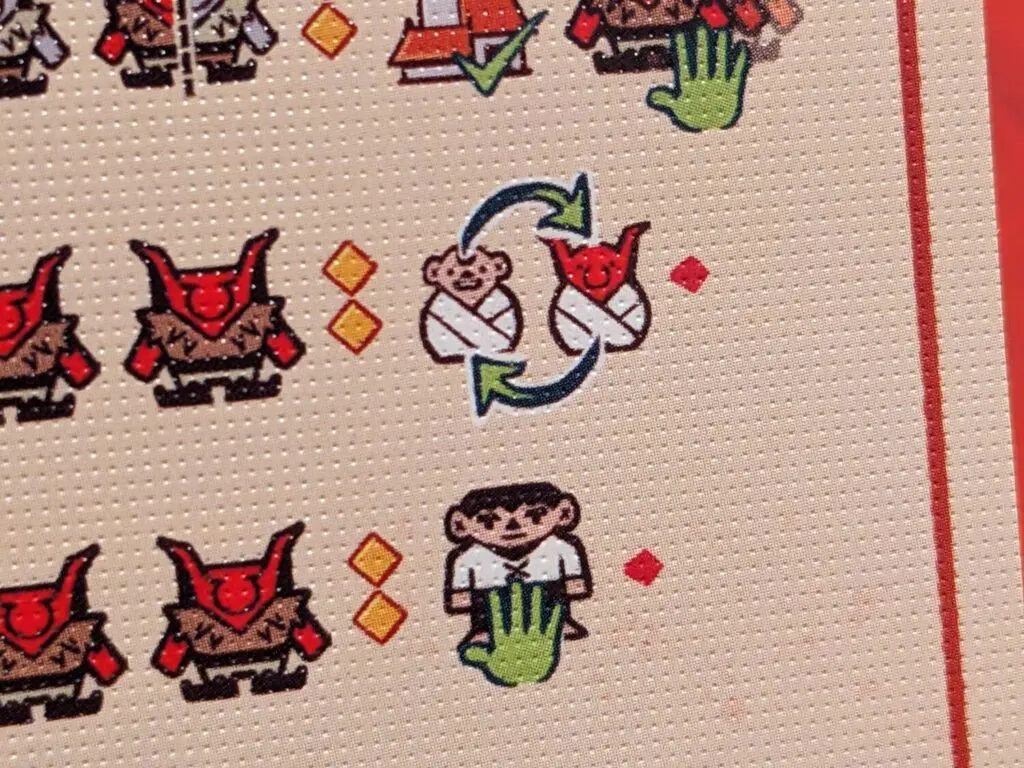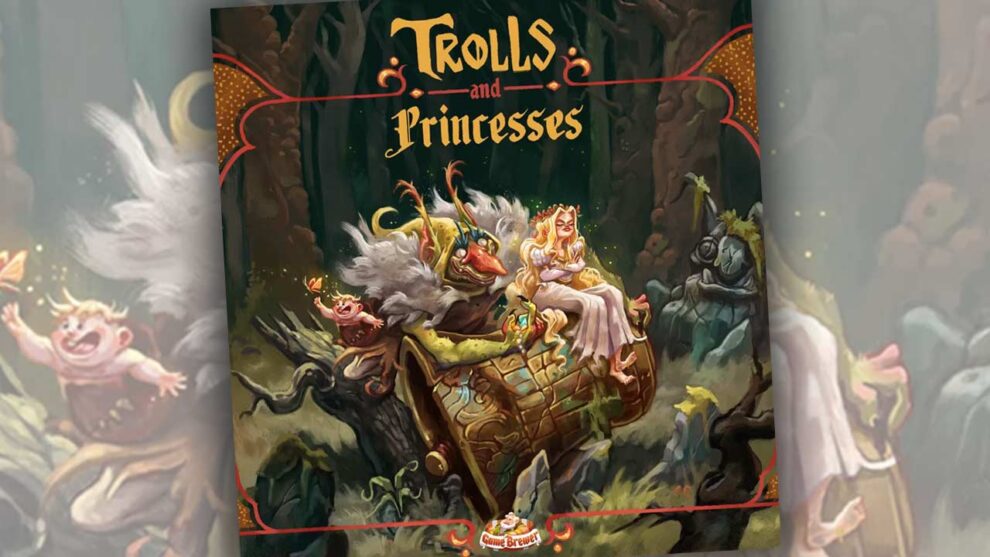They had me with the cover art.
With the release of Trolls & Princesses, Game Brewer has once again given the world a fantastic physical production. The publisher, known for Eurogame titles like Oak, Paris, Stroganov, Gentes, and Gùgōng, always nails the look: great components, clean box covers, sharp visuals, and games that might lean a little too hard into language-free iconography.
I have played Gentes and Oak, and enjoyed both games. With Trolls & Princesses, I raised my hand to cover this game right away thanks to the comical cover art of a nasty-looking troll holding a human baby and carting a princess (with a miffed look on her face) off to do who-knows-what. It’s a hard image to shake, which told me I needed to play the game.
Trolls & Princesses is interesting. As great as it looks, everyone who sat with me for plays (each of my plays took place with three players) came away from the game impressed by the production and amused by the game’s theme. But as a game, Trolls & Princesses mostly left players at “yeah, OK, that was fun” and not much more excited than that.
Part of the reason: the princesses.

“Church Bells, Changelings and Outposts” Doesn’t Have the Same Ring to It
Trolls & Princesses is a 2-4 player worker placement, set collection scoring game played over a maximum of 12, depending on the player count. As leaders of various troll clans, players have to outperform rivals at different tasks, such as mining resources, gaining troll power, building outposts and stealing things (people, cows, and church bells) from human villages above ground. All the while, these tribes must slowly build out a network of cave tiles that grant more places for things to be stashed and resources to be mined.
Almost everything a player can do takes place on their player board. This area includes caverns (worker placement spots, known as cauldrons), the cave network, the “resource field” (where available resources reside), and a farm area where cows can be kept for spending later. On a larger village board, different sections represent towns where trolls can visit (again, using cauldrons) to swap baby trolls for baby humans, “hire” humans—yes, this sounds a lot like abduction because it is—and build outposts, which represent permanent troll power in each village.
Turns are fast. Using a deck of cards built during setup, each player has three cards in hand to begin a turn. The card requires the restocking of people (humans, changelings, princesses) into a certain village before the Troll King visits one part of the active player’s board to strengthen the action points of an area. Alternatively, the Troll King visits the village named on the card played that round.
Then players can take two actions. Trolls & Princesses is a worker placement game, with a twist: players must move a troll from one location to another to activate a region’s action. Then, counting up the number of trolls, abducted humans, and the Troll King in that area, there are a certain allotment of action points (APs) available to spend on an action. In this way, you can do as many things as your AP limit allows. Above ground, it gets spicier—your APs comprise not only your own trolls, but other player trolls, your own outposts, and the Troll King if he’s around.
Setting up an action underground then doing something cool above ground, or vice versa, is the heart of the fun in Trolls & Princesses, and I’ll admit that my most enjoyable moments in each game came when I planned out ways to have a juicy two-turn combo with multiple actions during both turns. This is particularly true late in games, when all of your five trolls are in your play area (they begin the game off the board). Oohs and aahs were uttered during a lot of turns late in each of my plays, and those moments give the game a real boost.

In three-player games, you get 22 total actions (11 rounds). And within those 22 actions, you are probably doing 30-40 different mini-actions to use up all of your APs during the game. It seemed like a lot on paper, but happily, the turns are quick and my games usually took about 30 minutes per player. 90 minutes for Trolls & Princesses felt right.
After a player takes their two actions and draws the next action card into their hand, their turn is over. Final scoring is tied to a mix of things, and while the act of stealing a princess scores you 10 points (seven for the princess and three for a King’s Tile, a special cave tile that gets you better actions), the real meat of the scoring comes from a set collection element: for every set of church bell, changeling, and outpost you place on the board (and by extension, swap for items in your cave network and player board), you score 15 points.
This led us to one of our biggest questions during Trolls & Princesses: is it EVER worth going after princesses? The act of kidnapping a princess requires a diamond (the most valuable resource in the game), two troll power (a spendable resource, tracked on your player board), and five troll APs. In many cases, it almost felt like going after princesses is a handsome secondary option when the stars align and you have a cave tile outfitted for a princess in your cave network (in a cute twist, princesses will only accept capture if they have a place to sleep…board games).
In each of my games, the person with the lowest score has also been the player who went too hard on princesses. It takes half the game to get the APs needed to even get the princesses, unless a lot of players send trolls to one village.
Now, the game is called Trolls & Princesses, so I see why people are tempted to go after princesses. I like games like Evacuation for this reason: the player who does the best job evacuating is going to win. In Dwellings of Eldervale, the person who builds the most dwellings is usually going to win. In Trolls & Princesses…there are princesses in the game, but it feels like a classic red herring to pursue getting princesses out of each village.

It’s So Pretty
Trolls & Princesses is fun because it doesn’t take itself too seriously. It’s lighter fare that can be taught to players of varying tabletop experience in about 20 minutes. It is absolutely hilarious to say “I’m going to spend a cow, one troll power, and an action point to take that troll card that lets me move my abducted human worker to a different cauldron” or “You know what? I need to get into that baby game; I’m going to spend two gold, some troll power and a couple action points to swap my teal baby in for that white one.”
Seriously! If you are going to play a by-the-numbers Euro, I want something to really sing to me. The theme of Trolls & Princesses is that theme. You want to know what the first-player condition here is?
Whoever has the biggest nose.

Trolls & Princesses has production in spades. The gameplay is good, with a few exceptional moments in each game. But the gameplay has its share of problems. Scoring, for one, particularly around princesses. Once you know that princesses are a bad idea, you’ll work around that in future plays, but still, it’s weird to warn new players that they should only go after princesses as a backup option.
The game is naturally a slow starter, thanks to your troll power residing off the board when play begins. In the first few rounds, you’ll mine one obsidian token here, or steal a cow there. Meh. The back half of this game has all the combos, but the first half of the game is not thrilling.
Lots of things in the game give an owner one or two points at the end of the game if they have certain troll scoring cards. I’m not sure this feels meaningful enough to pursue on its own. Also, resources are somewhat easy to come by later in the game, but resources are worth nothing unless you have a card that specifically scores them. Trolls & Princesses is mostly a set collection game, because even if you don’t have a full set of the church bell/changeling/outpost trinity, even one of those three items still gets you four points. All I did in my third play was to go after that mix of points. If you get all of your pieces on the board, that’s 60 points. 60 points plus a couple of King’s Tiles should be enough to win in most of your games.
That means replayability is narrow—you are always doing basically the same thing to win. (I am confident there is no such thing as a princess strategy. The most captured princesses I have seen in a game were three; not what dreams are made of!!)
Trolls & Princesses is a fun time at the table, and even when the interaction is light, everyone is laughing as they are taking their actions. Designer Pim Thunborg seems like they are having fun and the artwork by Edu Valls is really special. The production lifts the gameplay into recommended territory, so give this a look if troll worker placement games are your thing!












Add Comment